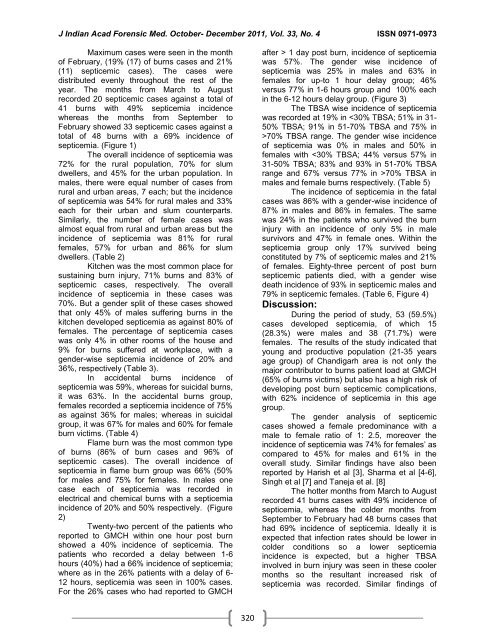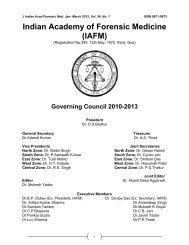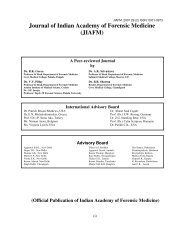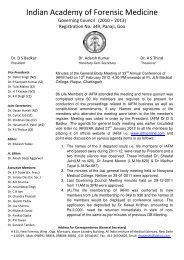Indian Academy of Forensic Medicine (IAFM) - Official website of IAFM
Indian Academy of Forensic Medicine (IAFM) - Official website of IAFM
Indian Academy of Forensic Medicine (IAFM) - Official website of IAFM
You also want an ePaper? Increase the reach of your titles
YUMPU automatically turns print PDFs into web optimized ePapers that Google loves.
J <strong>Indian</strong> Acad <strong>Forensic</strong> Med. October- December 2011, Vol. 33, No. 4 ISSN 0971-0973<br />
Maximum cases were seen in the month<br />
<strong>of</strong> February, (19% (17) <strong>of</strong> burns cases and 21%<br />
(11) septicemic cases). The cases were<br />
distributed evenly throughout the rest <strong>of</strong> the<br />
year. The months from March to August<br />
recorded 20 septicemic cases against a total <strong>of</strong><br />
41 burns with 49% septicemia incidence<br />
whereas the months from September to<br />
February showed 33 septicemic cases against a<br />
total <strong>of</strong> 48 burns with a 69% incidence <strong>of</strong><br />
septicemia. (Figure 1)<br />
The overall incidence <strong>of</strong> septicemia was<br />
72% for the rural population, 70% for slum<br />
dwellers, and 45% for the urban population. In<br />
males, there were equal number <strong>of</strong> cases from<br />
rural and urban areas, 7 each; but the incidence<br />
<strong>of</strong> septicemia was 54% for rural males and 33%<br />
each for their urban and slum counterparts.<br />
Similarly, the number <strong>of</strong> female cases was<br />
almost equal from rural and urban areas but the<br />
incidence <strong>of</strong> septicemia was 81% for rural<br />
females, 57% for urban and 86% for slum<br />
dwellers. (Table 2)<br />
Kitchen was the most common place for<br />
sustaining burn injury, 71% burns and 83% <strong>of</strong><br />
septicemic cases, respectively. The overall<br />
incidence <strong>of</strong> septicemia in these cases was<br />
70%. But a gender split <strong>of</strong> these cases showed<br />
that only 45% <strong>of</strong> males suffering burns in the<br />
kitchen developed septicemia as against 80% <strong>of</strong><br />
females. The percentage <strong>of</strong> septicemia cases<br />
was only 4% in other rooms <strong>of</strong> the house and<br />
9% for burns suffered at workplace, with a<br />
gender-wise septicemia incidence <strong>of</strong> 20% and<br />
36%, respectively (Table 3).<br />
In accidental burns incidence <strong>of</strong><br />
septicemia was 59%, whereas for suicidal burns,<br />
it was 63%. In the accidental burns group,<br />
females recorded a septicemia incidence <strong>of</strong> 75%<br />
as against 36% for males; whereas in suicidal<br />
group, it was 67% for males and 60% for female<br />
burn victims. (Table 4)<br />
Flame burn was the most common type<br />
<strong>of</strong> burns (86% <strong>of</strong> burn cases and 96% <strong>of</strong><br />
septicemic cases). The overall incidence <strong>of</strong><br />
septicemia in flame burn group was 66% (50%<br />
for males and 75% for females. In males one<br />
case each <strong>of</strong> septicemia was recorded in<br />
electrical and chemical burns with a septicemia<br />
incidence <strong>of</strong> 20% and 50% respectively. (Figure<br />
2)<br />
Twenty-two percent <strong>of</strong> the patients who<br />
reported to GMCH within one hour post burn<br />
showed a 40% incidence <strong>of</strong> septicemia. The<br />
patients who recorded a delay between 1-6<br />
hours (40%) had a 66% incidence <strong>of</strong> septicemia;<br />
where as in the 26% patients with a delay <strong>of</strong> 6-<br />
12 hours, septicemia was seen in 100% cases.<br />
For the 26% cases who had reported to GMCH<br />
320<br />
after > 1 day post burn, incidence <strong>of</strong> septicemia<br />
was 57%. The gender wise incidence <strong>of</strong><br />
septicemia was 25% in males and 63% in<br />
females for up-to 1 hour delay group; 46%<br />
versus 77% in 1-6 hours group and 100% each<br />
in the 6-12 hours delay group. (Figure 3)<br />
The TBSA wise incidence <strong>of</strong> septicemia<br />
was recorded at 19% in 70% TBSA range. The gender wise incidence<br />
<strong>of</strong> septicemia was 0% in males and 50% in<br />
females with 70% TBSA in<br />
males and female burns respectively. (Table 5)<br />
The incidence <strong>of</strong> septicemia in the fatal<br />
cases was 86% with a gender-wise incidence <strong>of</strong><br />
87% in males and 86% in females. The same<br />
was 24% in the patients who survived the burn<br />
injury with an incidence <strong>of</strong> only 5% in male<br />
survivors and 47% in female ones. Within the<br />
septicemia group only 17% survived being<br />
constituted by 7% <strong>of</strong> septicemic males and 21%<br />
<strong>of</strong> females. Eighty-three percent <strong>of</strong> post burn<br />
septicemic patients died, with a gender wise<br />
death incidence <strong>of</strong> 93% in septicemic males and<br />
79% in septicemic females. (Table 6, Figure 4)<br />
Discussion:<br />
During the period <strong>of</strong> study, 53 (59.5%)<br />
cases developed septicemia, <strong>of</strong> which 15<br />
(28.3%) were males and 38 (71.7%) were<br />
females. The results <strong>of</strong> the study indicated that<br />
young and productive population (21-35 years<br />
age group) <strong>of</strong> Chandigarh area is not only the<br />
major contributor to burns patient load at GMCH<br />
(65% <strong>of</strong> burns victims) but also has a high risk <strong>of</strong><br />
developing post burn septicemic complications,<br />
with 62% incidence <strong>of</strong> septicemia in this age<br />
group.<br />
The gender analysis <strong>of</strong> septicemic<br />
cases showed a female predominance with a<br />
male to female ratio <strong>of</strong> 1: 2.5, moreover the<br />
incidence <strong>of</strong> septicemia was 74% for females‘ as<br />
compared to 45% for males and 61% in the<br />
overall study. Similar findings have also been<br />
reported by Harish et al [3], Sharma et al [4-6],<br />
Singh et al [7] and Taneja et al. [8]<br />
The hotter months from March to August<br />
recorded 41 burns cases with 49% incidence <strong>of</strong><br />
septicemia, whereas the colder months from<br />
September to February had 48 burns cases that<br />
had 69% incidence <strong>of</strong> septicemia. Ideally it is<br />
expected that infection rates should be lower in<br />
colder conditions so a lower septicemia<br />
incidence is expected, but a higher TBSA<br />
involved in burn injury was seen in these cooler<br />
months so the resultant increased risk <strong>of</strong><br />
septicemia was recorded. Similar findings <strong>of</strong>









